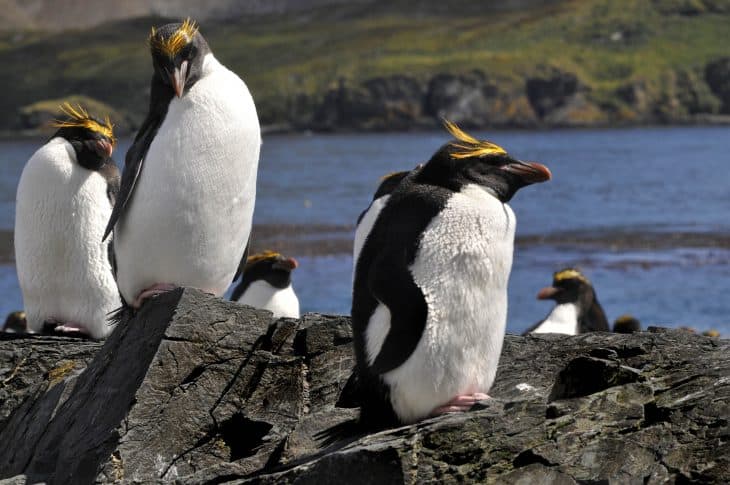
- Scientific Name: Eudyptes chrsolophus
- Higher Classification: Crested Penguin
- Rank: Species
- Weight: Approximately 12 pounds (5.5 kilograms)
- Height: Approximately 28 inches (71 centimeters)
- Range: Circumpolar
- Predators: Skuas, sheathbills, kelp gulls, giant petrels, leopard seals, Antarctic fur seals, killer whales and sharks
- Diet: Small fish, squid and krill
- Largest Colony: 3 million breeding pairs on South Georgia Island
- Life Span: Approximately 15 years in the wild
- Movement: Too Stiff to Fly, Macaroni Penguins Make Excellent Swimmers
- Appearance: Macaroni Penguins Have Distinctive Feathers on Their Heads
- Appearance: Macaroni Penguins Molt Annually
- Migration: Macaroni Penguins Migrate Every Year
- Behavior: Macaroni Penguins Are Excellent Hunters – Even at Night
- Diet: Macaroni Penguins Consume 9 Million Tons of Krill Every Year
- Reproduction: Both Male and Female Macaroni Penguins Are Nurturing
- Nesting: Macaroni Penguin Nests Are Lined with Rocks
- Offspring: Macaroni Penguin Chicks Attend Crèche
- Behavior: Macaroni Penguins Aren’t Aggressive, Until They Fall in Love
- Female Macaroni Penguins Are Fussy about Their Mates
- Macaroni Penguins Are Monogamous and Reunite Every Year
- Macaroni Penguins Are Named after Hats, Not Pasta
- Macaroni Penguins Made it to Hollywood in Happy Feet
- Macaroni Penguins Are Vulnerable and Need to Be Conserved
Macaroni Penguin Facts Infographics
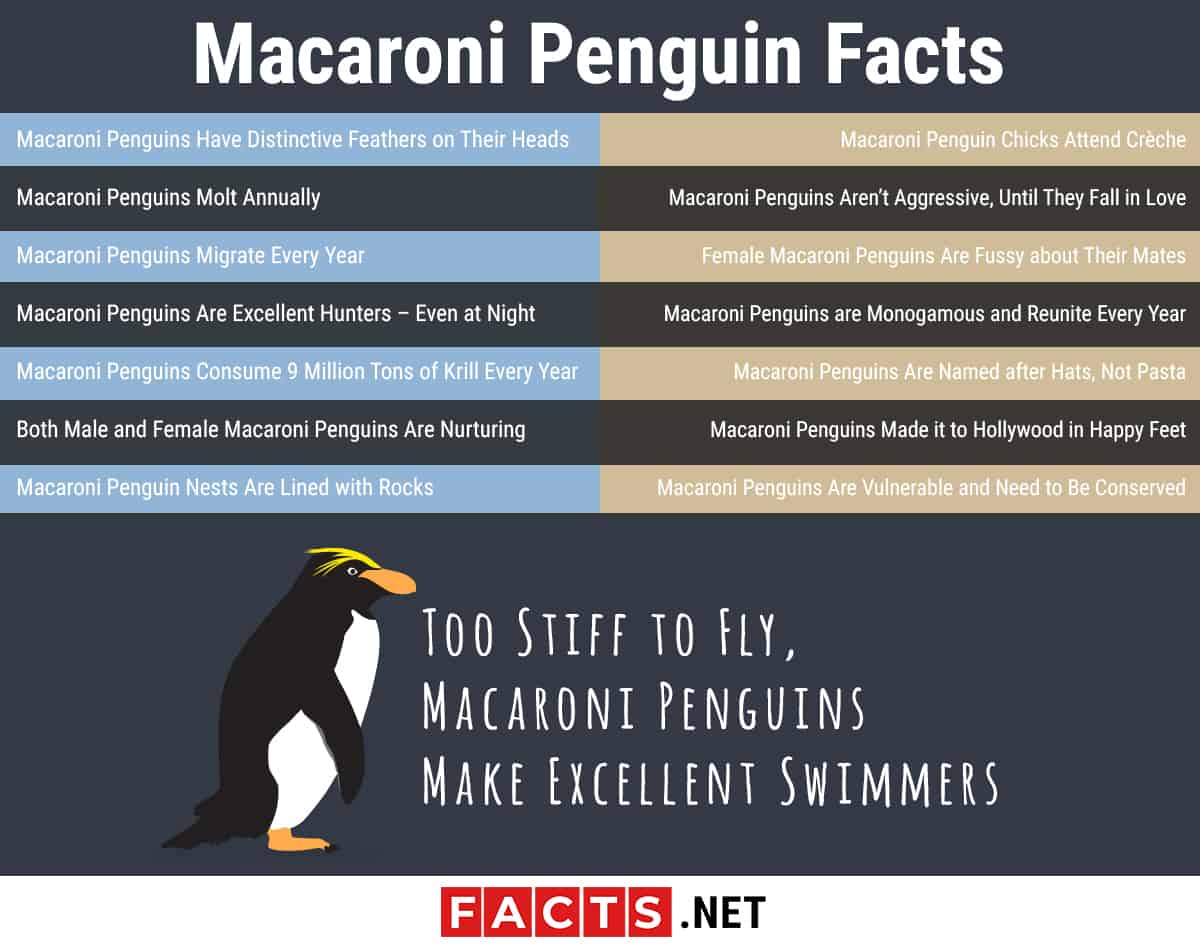
Too Stiff to Fly, Macaroni Penguins Make Excellent Swimmers
Macaroni Penguins are unable to fly because their wings are small and very stiff. However, these penguins more than make up for their inability to fly with their impressive prowess as swimmers. Their swimming skills are largely due to the design of their flippers.
Macaroni Penguins Have Distinctive Feathers on Their Heads

At first glance it can seem difficult to distinguish between the different species of penguins. However, it is easy to identify Macaroni Penguins. One of the established Macaroni Penguin facts is that these birds have very dark yellow and black feathers on the tops of their heads.
Macaroni Penguins Molt Annually
One of the more interesting Macaroni Penguin facts is that these birds molt every year. This process involves the penguins losing all their feathers so that they can be replaced by new ones. Throughout the molting process, Macaroni Penguins can look remarkably different in appearance.
Macaroni Penguins Migrate Every Year

Macaroni Penguins migrate on an annual basis, seeking different locations to their usual spots. These penguins prefer a cooler climate. As such, they can be found in the Arctic Peninsula, Sub Antarctic regions, South America and the surrounding islands.
Macaroni Penguins Are Excellent Hunters – Even at Night
One of the lesser known Macaroni Penguin facts is that these birds are excellent hunters. They can swim incredibly quickly, enabling them to catch their prey in the water with ease. If the supply of food is not plentiful near the surface, Macaroni Penguins are able to dive to great depths to hunt for edible critters. Because of their amazing vision, these penguins are even able to hunt in the sea at night.
Macaroni Penguins Consume 9 Million Tons of Krill Every Year
Krill is a major component of the Macaroni Penguin’s diet. There are several million Macaroni Penguins around the world and it’s estimated that between them, these penguins consume anywhere from 4 to 9.2 million tons of krill each year!
Both Male and Female Macaroni Penguins Are Nurturing
One of the more endearing Macaroni Penguin facts is that both parents play an important nurturing role. After the female has laid an egg, both parents take turns incubating the egg for about 34 days. After the chick has hatched, the father takes care of his offspring for three weeks, keeping it warm, whilst the mother assumes responsibility for bringing food to her chick.
Macaroni Penguin Nests Are Lined with Rocks
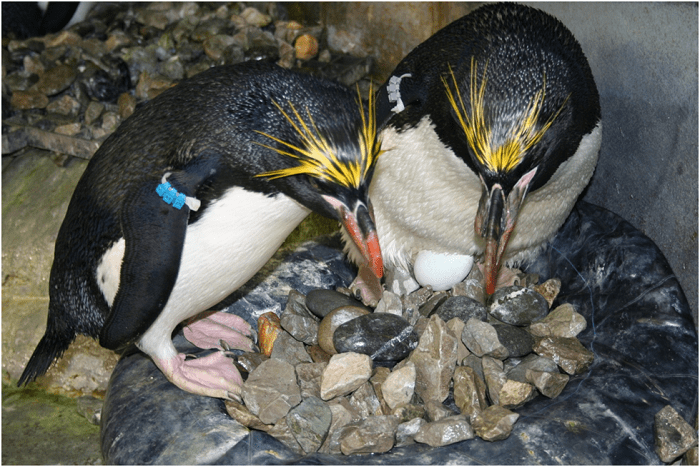
Macaroni Penguins tend to build very simple nests. These nests usually consist of a scrape in the ground which is then lined with small stones. Each nest measures approximately 34 inches (86 centimeters) in circumference. If the eggs are lucky, the parents will build the nest on a small patch of grass and line the nest with grass shoots.
Macaroni Penguin Chicks Attend Crèche
Of all Macaroni Penguin facts, one of the most intriguing is the fact that these penguins are very sociable animals. This is particularly noticeable amongst the young. Macaroni Penguin chicks form crèches where they huddle together to keep warm and to stay protected.
Macaroni Penguins Aren’t Aggressive, Until They Fall in Love
As has been established, Macaroni Penguins are very sociable and tend to get along very well. They are noticeably less aggressive than other species of penguins. However, aggression can be seen in certain circumstances. Macaroni Penguins can be very protective of their young. The females can also get aggressive when competing for the attention of a male with whom they would like to mate.
Female Macaroni Penguins Are Fussy about Their Mates
One of the more amusing Macaroni Penguin facts is that the females are known to be extremely selective during the process of choosing a mate. They can afford to be picky because the female Macaroni Penguins are substantially outnumbered by the males.
Macaroni Penguins are Monogamous and Reunite Every Year
Macaroni Penguins are monogamous, meaning that once a pair mate, they will mate for life. Every year in October and November, all Macaroni Penguins return to their breeding colonies. Usually the male penguins arrive at the colony before the females. Each pair will reunite at their nesting site. The Macaroni Penguin colonies are large and expansive, so a pair will recognize each other by their unique calls.
Macaroni Penguins Are Named after Hats, Not Pasta
When explorers first discovered the Macaroni Penguins, they were immediately struck by the distinctive yellow feathered crest on the penguins’ heads. These feathers reminded the explorers of the feathers that featured on fashionable hats worn by men in the 18th century, which were referred to as macaronis. The Macaroni Penguins were thus named – after stylish hats rather than Italian pasta! Perhaps you are familiar with the famous song Yankee Doodle, which features the line: Stuck a feather in his cap and called it macaroni. It seems the Macaroni Penguin had the same fate.
Macaroni Penguins Made it to Hollywood in Happy Feet
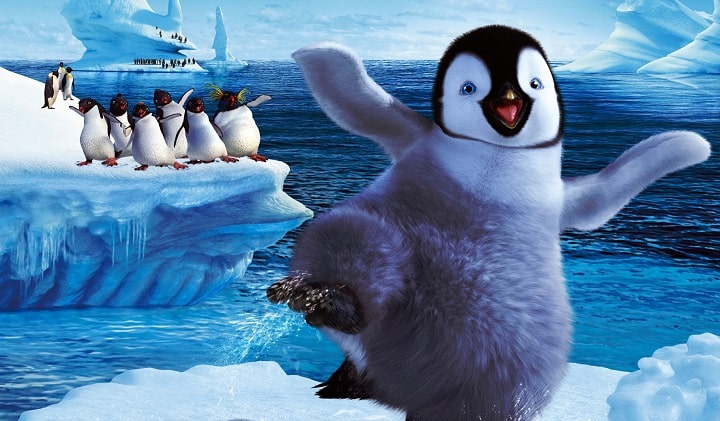
The film Happy Feet has entertained countless children and adults alike over the years. One of the most delightful Macaroni Penguin facts for kids is that the character Lovelace in this animated film is actually a Macaroni Penguin.
Macaroni Penguins Are Vulnerable and Need to Be Conserved
One of the most alarming Macaroni Penguin facts is that these birds are deemed to be a vulnerable species in conservation terms. This is because the number of Macaroni Penguins is falling at an alarming rate. Reasons for this include that these birds have many natural predators, and that humans are damaging their natural habitats. Conservation efforts currently focus on preserving this natural habitat so that the Macaroni Penguin can once again thrive.
Macaroni Penguin Facts – Facts about Macaroni Penguins Summary
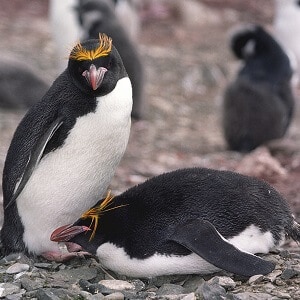 Macaroni Penguins are large, sociable penguins that live in large colonies in a circumpolar range. Their distinctive crest of yellow feathers helps distinguish them from other penguins, and is also responsible for their name. Macaroni Penguins are excellent swimmers and hunters, returning every year to their breeding grounds to find their monogamous mate and breed again.
Macaroni Penguins are large, sociable penguins that live in large colonies in a circumpolar range. Their distinctive crest of yellow feathers helps distinguish them from other penguins, and is also responsible for their name. Macaroni Penguins are excellent swimmers and hunters, returning every year to their breeding grounds to find their monogamous mate and breed again.
Was this page helpful?
Our commitment to delivering trustworthy and engaging content is at the heart of what we do. Each fact on our site is contributed by real users like you, bringing a wealth of diverse insights and information. To ensure the highest standards of accuracy and reliability, our dedicated editors meticulously review each submission. This process guarantees that the facts we share are not only fascinating but also credible. Trust in our commitment to quality and authenticity as you explore and learn with us.
